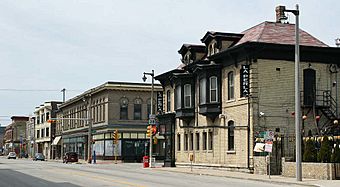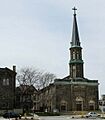Walker's Point Historic District facts for kids
Quick facts for kids |
|
|
Walker's Point Historic District
|
|

A portion of the district.
|
|
| Location | Roughly bounded by the Freeway, Menomonee Canal, Scott, 2nd, and W. VA. Sts. Milwaukee, Wisconsin |
|---|---|
| NRHP reference No. | 78000120 |
| Added to NRHP | December 19, 1978 |
The Walker's Point Historic District is a lively neighborhood in Milwaukee, Wisconsin. It has a mix of old homes, shops, churches, and factories. Some buildings here are very old, dating back to 1849! You can even find parts of the old Philip Best Brewery and the Pfister and Vogel Tannery.
In 1978, this special area was added to the National Register of Historic Places. This means it's an important place in history that should be protected. Walker's Point is unique because it still looks much like it did in the 1800s and early 1900s.
Contents
What Is the History of Walker's Point?
How Did Walker's Point Begin?
In 1833, a man named George Walker came to the wild area that would later become Milwaukee. In 1834, he claimed 160 acres of land. This land was on a point south of where the Milwaukee and Menomonee Rivers meet.
George Walker built a simple cabin and a trading post there. This spot is now the east side of Fourth Street, near Bruce Street. He chose this place because it was on a low ridge. Much of the land around it was wet and marshy. The ridge itself was covered with hawthorn and hazelnut bushes. Two Native American paths also crossed the ridge, leading to the river. A village of Potawatomi people lived nearby.
Who Were the First Settlers?
George Walker might have been the first settler south of the rivers. But Solomon Juneau had been trading furs nearby since 1819. His trading post was east of the Milwaukee River. By the 1830s, the area around his post was growing into 'Juneautown.'
Around the same time, Byron Kilbourn started another town. This town was on the west side of the Milwaukee River and was called 'Kilbourntown.' Walker's Point grew more slowly than these other two settlements. It wasn't even officially mapped out until 1842.
However, by 1846, 1,366 people lived in Walker's Point. That year, the three settlements (Juneautown, Kilbourntown, and Walker's Point) joined together. They officially became the City of Milwaukee.
How Did the Population Grow?
By 1855, Walker's Point had 3,843 people living there. A large number of these people, 3,017, were immigrants. Most of them were German immigrants. But there were also many people from Scandinavia and Ireland. In the 1870s and 1880s, Polish immigrants also moved to the area.
What Industries Were in Walker's Point?
The first brewery opened in Walker's Point in 1841. Later, the large Philip Best Brewing Co. opened. This company later became Pabst, a famous beer company. The Pfister and Vogel leather tannery also opened here.
After World War I, the area had many different industries. These included warehouses for steamships and storage. There were also grain elevators, coal yards, and lumber yards. Other businesses included tanneries, salt warehouses, and meat packing plants. Many other smaller factories were also in the area.
What Are Some Notable Buildings?
The Walker's Point neighborhood has a mix of buildings. You can find small workers' cottages and large homes designed by architects. There are also small craft shops and big factories. Here are some of the important old buildings that are still standing:
- The Holy Trinity Roman Catholic Church at 605 S. Fourth St. was built in 1849. It was designed by Victor Schulte in a style called Zopfstil. This German style was similar to the American Federal style. Many early German immigrants in the area would have known this style. The church's tower was added in 1862. The building still looks much like it did during the Civil War.
- The William Howard house at 910 S. Third St. was built in 1854. It's a 1.5-story wooden house in the Greek Revival style. It has special details like cornice returns and a doorway framed with pilasters. William Howard worked on cargo ships.
- The Vullmahn cobbler shop at 807 S. Second St. is a 2-story wooden building. It was built in the late 1860s in the Italianate-style, which is quite unusual for a wooden building. Frederick Vullman bought the land in 1863. He made boots and shoes here and lived upstairs.
- Holy Trinity School at 621 S Fourth St. is part of the Holy Trinity complex. It's a 3-story building in the Italianate-style, built in 1867.
- The Jasper Humphrey house at 634 S. Third Street is a 2-story brick house. It has limestone trim and was designed by John Rugee. It was built in 1868. The style is High Victorian Italianate. It has a cornice arched above the center window and a cupola on the roof. Jasper Humphrey was a sailor and ship captain. He helped rescue people from a shipwreck in 1855. He also served as an alderman (a city council member) and a state assemblyman. From 1877, he was the Harbor master for the Port of Milwaukee.
- Tannery buildings of the Pfister and Vogel Leather Company are still on W. Oregon St. They are located along the Menomonee Canal. Guido Pfister and Fred Vogel were German immigrants. They opened a leather goods store in Milwaukee by 1847. The next year, they started building their tannery on the south side. By 1855, nine tanneries were working in Milwaukee. They used tree bark and other materials to turn animal hides into leather. By 1872, Milwaukee was the biggest leather-tanning center in the world. Pfister and Vogel had the largest tannery in Milwaukee.
- Buildings of the Philip Best Brewing Company (later Pabst) are on W. Virginia St. Best bought the Menomonee Brewery in 1869. By 1881, the complex had a bottling plant, malthouses, a grain elevator, and ice houses. It also had a cooper shop (where barrels are made) and stables. In 1889, Frederick Pabst took over the company. He sold most of these buildings on the south side to Pfister and Vogel.
- The Scandinavian Evangelical Lutheran Church at 202 W Scott St. was built in 1882. It was designed by Andrew Elleson for its Norwegian church members. The style is Gothic Revival, which is common for churches. Around 1922, the church moved. The spire was taken off, and the windows were changed. After that, the building became a candy factory!
- The Bahr Grocery at 801-805 S. Second St. is a 2-story brick building from 1887. Frederick M. Bahr was an immigrant from West Prussia. He came to Milwaukee in 1857. This corner building is in the Victorian Italianate style. It has a fancy metal cornice and a weather-vane on top of a tall central spire.
- The Fifth Ward School at 823 S. Fourth St is a 2.5-story building built in 1894. It was designed by Ferry & Clas. Its shape and gable ends suggest a Flemish Renaissance Revival style.
- The William George Bruce house at 1137 S. 3rd St. is a 2.5-story house built in 1896. It was designed by A.C. Seims. The house has a mix of styles. The bay window and shingles suggest Queen Anne style. The Palladian windows in the gables are from Classical Revival. The stonework on the front might be Romanesque. William George Bruce was the president of Bruce Publishing. He wrote books about Milwaukee's history. He was also an important Catholic leader and served on the Milwaukee school board.
- The Tivoli Palm Garden at 500 W. National Ave. is a 2-story building. It was a beer garden and dance hall. It was designed by Charles Kirchoff and built in 1901. Its Neoclassical styling is still on the second story. The first floor has been changed. Originally, it had a large beer garden/dance hall with a dome and tropical murals. It also had a barbershop, a bowling alley, shops, and offices.
- St. Stephen's Evangelical Lutheran Church at 1136 S. Fifth St. was designed by Otto Uehling. It was built in 1901 in the High Victorian Gothic style. The church group was started by German immigrants in 1854. They had a building on this spot since 1866. The tower from that 1866 building was used in the new 1901 building and covered with brick.
The Walker's Point Historic District was added to the National Register of Historic Places in 1978. It was also added to the State Register of Historic Places in 1989.
Images for kids


